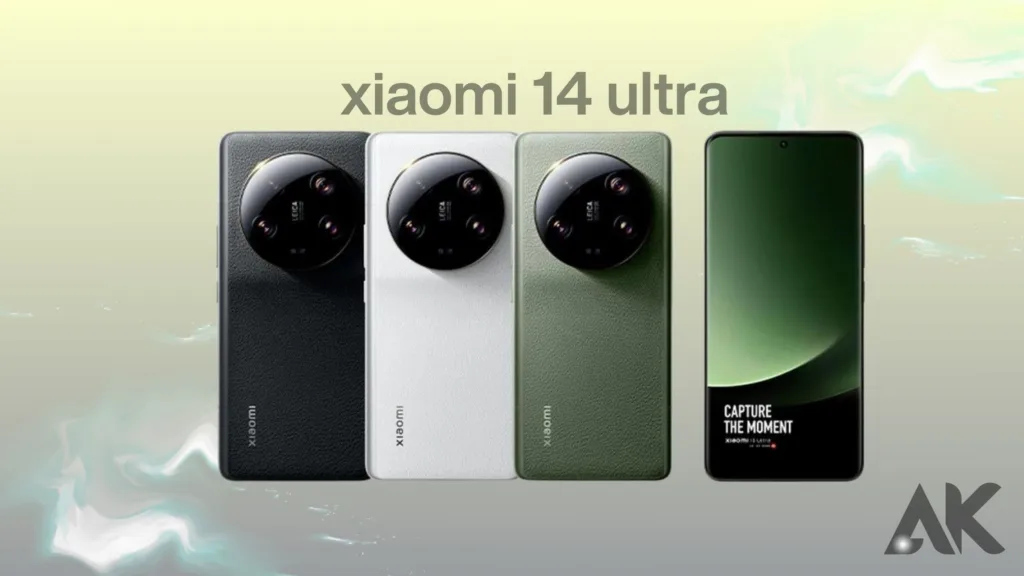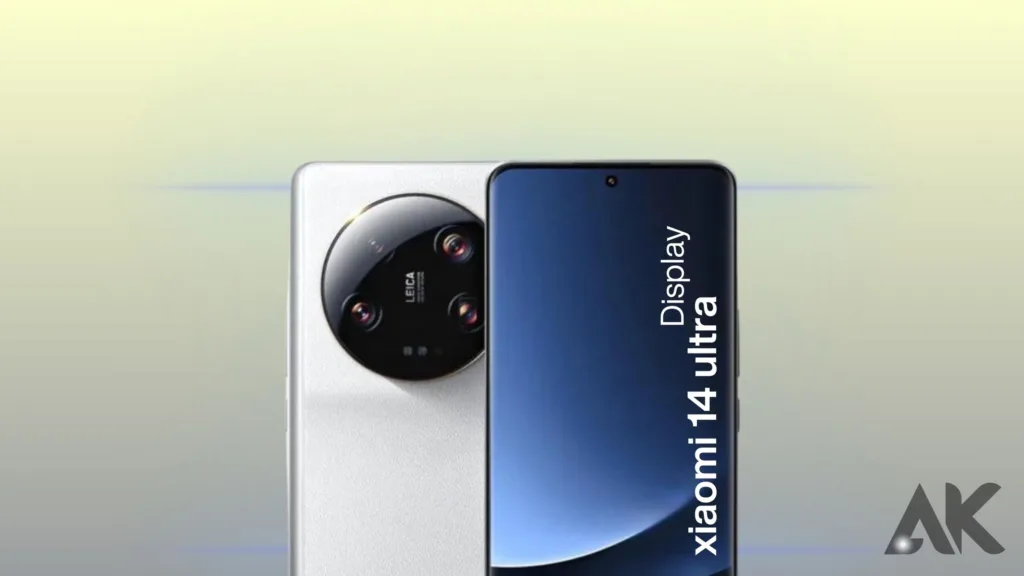Xiaomi 14 Ultra review: Explore the state-of-the-art features of the Xiaomi 14 Ultra with our detailed blog. We examine this flagship handset in detail, covering everything from its stylish appearance and long battery life to its exceptional photography features. Find out how the Xiaomi 14 Ultra claims to improve your photographic skills with its cutting-edge Snapdragon 8 Gen 3 CPU, massive 5,500mAh battery, and top-notch camera system. Our blog has all the information you need to understand why the Xiaomi 14 Ultra is a tech global sensation, whether you’re interested in its performance, design, battery life, or camera.
Xiaomi 14 Ultra Design

This phone’s aesthetics are its worst flaw. If the 12 and 13 were regressions in Xiaomi’s camera module, the 14 is an even more egregious case of regression. The design is instantly recognizable to anybody who has used or seen a very inexpensive budget phone: the flash remains in the wrong place while posing as a camera, and the LEICA logo resembles a man on the subway, smothered by the three cameras. I mean, it’s hideous. I wouldn’t consider purchasing this phone at all if its specifications weren’t much better.
Xiaomi 14 Ultra Display
No changes have been made to the beloved flat-screen display of the Xiaomi 14 Ultra Standard Edition. This panel is sourced from the most recent model from TCL, the C8. All the specs are available for you to see. The most noticeable improvement is the resolution boost, which is great news for bookworms thanks to the increased clarity that comes with 1200P.

Note that you must enable the Anti-flicker setting to activate DC dimming at any brightness level. Similar to the Xiaomi 13, it is set to 480Hz PWM dimming at low brightness and DC at high brightness by default when turned off.
Additionally, brightness has been enhanced in the software. Take the new Sunlight mode as an example; it doubles the manual maximum brightness from 500 nits to 670 nits, which may reach close to 1000 nits when stimulated by intense light. They claim that 3000nit is only possible with a 10% HDR video window when subjected to intense light. Unless you often view HDR films outside, the 3000nit peak brightness is a marketing ploy.
Xiaomi 14 Ultra Size
I’ve always thought it was a good idea to keep things as lightweight as possible if they were to be carried around. Everything I bring with me daily is electronic. Everything from the iPad mini 6 to the 65W PD charger, 33W Pocket Power Bank, and even the wires I use are 50cm in length. Similar to how much I like the Xiaomi 14 Ultra, they are small in size but yet strong.
It’s safe to assume that a few of you will remark that the Xiaomi 14 Ultra is no little phone. However, only five of last year’s 200 new phones were smaller than the Xiaomi 13. The 6.3-inch Xiaomi 14 Ultra is, thus, a little phone.
This is a repeat of what I mentioned in the Unboxing video: the infrared emitter that was previously on top of the Xiaomi 14 Ultra was relocated to the camera module. The Mi Remote App will recommend a very clumsy way to hold the smartphone when you first launch it. That is a really strange position. You won’t need to memorize that weird posture since it’s truly controllable in a regular position.
Xiaomi 14 Ultra Benchmark & Gaming
The greatest phone processor currently available is the Snapdragon 8 Gen 3. With 8 Gen 2 being so good last year, I didn’t anticipate such a significant improvement in 8 Gen 3. 8 Gen 3 achieved the highest scores in several areas. On top of that, the Xiaomi 14 Ultra did quite well in stability testing. To the best of my knowledge, it has the most powerful mobile CPU that I have ever seen.

The time has come to test its mettle in the real world. With PUBG Mobile’s low system requirements, even the Xiaomi 13 can comfortably operate at 90 frames per second. Is it the maximum you’re thinking of? No. Examine the Xiaomi 14 Ultra’s graph. This PUBG frame rate graph on the Xiaomi 14 Ultra is incredible; it has the straightest line I have ever seen. Reduced heat and battery consumption point to the new Snapdragon processor being able to handle light-load applications with ease.
Compared to other 8 Gen 2 phones, the Genshin Impact’s performance isn’t quite as remarkable as PUBG Mobile’s, but they’re still rather good. It took fifteen minutes of diving in Fontaine at the same 720p resolution for it to begin downclocking, and even then, the frame rate didn’t decrease much. Furthermore, it has the lowest power usage of any of them. I can’t wait to test out the larger Xiaomi 14 Ultra Pro and see if it lives up to the hype of providing an outstanding gaming experience on a smaller phone.
Xiaomi 14 Ultra Front Camera
Since Xiaomi phones seldom include a front-facing camera, I normally refrain from gushing over them. The Xiaomi 14 Ultra’s portraits have been fine-tuned, with most of the adjustments occurring in the skin tones. Compared to the Xiaomi 13, skin tones will seem better, and clarity has been improved.
The most critical improvement is that the front-facing camera can now capture movies at 4K 60fps with EIS support. You can get decent footage with the back camera as well. Similar to other flagship phones, it is steady, easy to see, and functions well. Now you may easily swap between the three cameras while shooting in 4K at 30 frames per second.
Xiaomi 14 ultra Camera
Leica mode on Xiaomi phones has some interesting trivia: the colors used for the mode are model-specific. The Xiaomi 13 Ultra has the most enticing Leica Authentic hues among the 13 models, whilst the 13 Standard is the least appealing. Although it lacks the Leica quality of the 13 Ultra, the Xiaomi 14 Ultra is an improvement over the 13. In Pro mode, colors are a lot brighter, contrast is better, and you have more customization choices.
The ability to flexibly change the tones adds a cinematic touch. On top of that, the normal edition of the 14 has all the improvements I described in the 13 Ultra screen test. To avoid an unexpected spike in exposure when a face is identified, you may set the metering option to Average, for instance. Photographers like myself are ecstatic about it.
The Light Hunter 900 is a brand-new sensor developed in collaboration with OmniVision and Xiaomi; its outstanding single-frame dynamic range is its primary selling feature. Sadly, it’s hardly perceptible and, when set to auto, only slightly outshines competing phones as the sun goes down. I am quite impressed by how well the 2x zoom works over the dynamic range. Improved image quality even in dim lighting is a result of the larger individual pixels. I found out after trying a bunch of different shots that the primary camera didn’t help things that much. I am much more impressed by the other two camera upgrades.
Xiaomi 14 Ultra Battery & Charging
When charging the Xiaomi 14 Ultra by wire, it uses 90W of electricity. The improvement may not be as substantial as it seems. There has been little change to the charging protocol, and the connector is still a USB-A. Now that the front-facing camera, USB transfer speed, and ultra-wide camera have all improved, the next logical step would be to include a USB-C connector on the charger.
A little improvement to the battery life has also been made. Improved battery life is to be expected given the larger battery size and more power-efficient chipset. It is just a 6.3-inch phone, so please, don’t have high expectations.
Conclusion
Xiaomi 14 ultra review? When I think about the Xiaomi 14 Ultra, I see a young guy going through puberty; he’s no longer gorgeous, but he’s maturing into a man. The issues we were previously complaining about have been resolved, and an update to the screen, camera, and CPU has been implemented. Not to mention, its incomparable size is a major plus. Having to put up with the less-than-desirable design is the only drawback of the
FAQs
Will there be a Xiaomi 14 Ultra?
With its next flagship product, the Xiaomi 14 Ultra, the Chinese tech company is now prepared for a worldwide confrontation. This smartphone is expected to make a splash in the Android market when it launches on February 25th at 15:00 GMT+1. It will go up against established players like the Galaxy S24 Ultra.
What is the processor of Xiaomi 14 Ultra?
The most recent Snapdragon 8 Gen 3 system on a chip from Qualcomm. A 120 Hz 2K AMOLED display measuring 6.7 inches in diagonal. A 5,180mAh battery that can be charged with either a 90W wired or 50W wireless charger. A fingerprint sensor that is ultrasonic and shown for security purposes.

